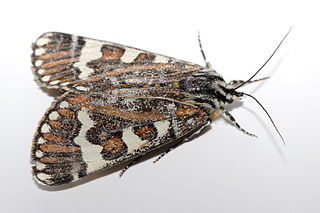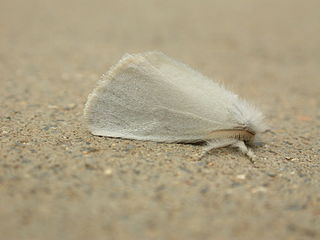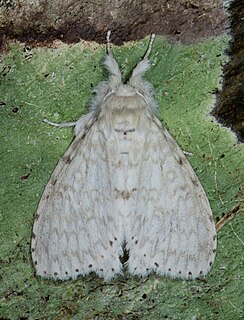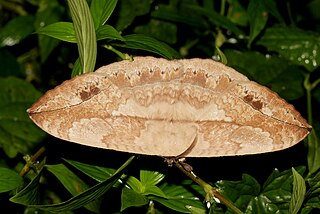
The pasture day moth, Apina callisto, is a species in the moth family Noctuidae which is active during the day, as its common name implies, making it unlike most other noctuid species. It is found in most southern areas of Australia, ranging from lower Queensland to Tasmania. The species was first described by George French Angas in 1847. It is the only species in the monotypic genus Apina, erected by Francis Walker in 1855.

Orgyia is a genus of tussock moths of the family Erebidae. The genus was described by Ochsenheimer in 1810. The species are cosmopolitan, except for the Neotropical realm.
Hemonia is a genus of moths in the family Erebidae first described by Francis Walker in 1863. They are found only in Sri Lanka and Borneo.

Paectes is a genus of moths of the family Euteliidae erected by Jacob Hübner in 1818.

Tephriopis is a monotypic moth genus of the family Erebidae. Its only species, Tephriopis divulsa, was first described by Francis Walker in 1865.

Throana is a genus of moths of the family Erebidae erected by Francis Walker in 1859. It consists of very small, slender species found mainly in Sundaland, with at least three species in Sulawesi, and outlying species in Seram and Australia.

Acyphas is a genus of tussock moths in the family Erebidae erected by Jacob Hübner in 1819.
Cimola is a monotypic moth genus in the subfamily Lymantriinae. Its only species, Cimola opalina, is found in South Africa. Both the genus and the species were first described by Francis Walker in 1855.

Dura is a genus of tussock moths in the family Erebidae. The genus was erected by Frederic Moore in 1879.
Etobema is a genus of moths in the subfamily Lymantriinae. The genus was erected by Francis Walker in 1865.
Icta is a genus of moths in the subfamily Lymantriinae. The genus was erected by Francis Walker in 1855. Both species are found in Australia.

Imaus is a genus of tussock moths in the family Erebidae. The genus was described by Moore in 1879.
Lacida is a genus of tussock moths in the family Erebidae. The genus was erected by Francis Walker in 1855.
Oligeria is a monotypic moth genus in the subfamily Lymantriinae described by Turner in 1921. Its only species, Oligeria hemicalla, the tiny tussock moth, was first described by Oswald Bertram Lower in 1905. It is found in the Australian states of New South Wales and Victoria.
Sarsina is a genus of moths in the subfamily Lymantriinae. The genus was erected by Francis Walker in 1855.
Varmina is a monotypic moth genus in the subfamily Lymantriinae described by Moore in 1888. Its only species, Varmina indica, was first described by Francis Walker in 1855. It is found in the East Indies.
Encryphia is a monotypic moth genus in the family Geometridae erected by Alfred Jefferis Turner in 1904. Its only species, Encryphia frontisignata, first described by Francis Walker in 1863, is found in Australia.
Lacistophanes is a monotypic moth genus in the family Geometridae. Its only species, Lacistophanes hackeri, is found in the Australian state of Queensland. Both the genus and species were first described by Turner in 1947.

Scotocyma is a genus of moths in the family Geometridae described by Turner in 1904. All the species in this genus are found in Australia.

Eupterote is a genus of moths in the family Eupterotidae. It was first described by Jacob Hübner in 1820.











